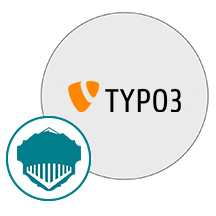TYPO3

- Apache
- PHP
- MySQL
- CMSMS
About

TYPO3 is credited to be highly flexible, as code and content are operated separately. It can be extended by new functions without writing any program code. Also, the software is available in more than 50 languages and has a built-in localization system, therefore supports publishing content in multiple languages.
TYPO3 is, along with Drupal, Joomla! and WordPress, among the most popular content management systems worldwide, however it is more widespread in Europe than in other regions.
Due to its features like editorial workplace and workflow, advanced frontend editing, scalability and maturity, TYPO3 is used to build and manage websites of different types and size ranges, from small sites for individuals to multilingual enterprise solutions for large corporations. According to the ability to support a corporate environment, it classifies itself as an enterprise level content management system.
Delivered with a base set of interfaces, functions and modules, TYPO3’s functionality spectrum is implemented by extensions. More than 5000 extensions are currently available for TYPO3 for download under the GNU from a repository called the TYPO3 Extension Repository, or TER.
- Type virtual machines in the search.
- Under Services, select Virtual machines.
- In the Virtual machines page, select Add. The Create a virtual machine page opens.
- In the Basics tab, under Project details, make sure the correct subscription is selected and then choose to Create new resource group. Type myResourceGroup for the name.*.
- Under Instance details, type myVM for the Virtual machine name, choose East US for your Region, and choose Ubuntu 18.04 LTS for your Image. Leave the other defaults.
- Under Administrator account, select SSH public key, type your user name, then paste in your public key. Remove any leading or trailing white space in your public key.
- Under Inbound port rules > Public inbound ports, choose Allow selected ports and then select SSH (22) and HTTP (80) from the drop-down.
- Leave the remaining defaults and then select the Review + create button at the bottom of the page.
- On the Create a virtual machine page, you can see the details about the VM you are about to create. When you are ready, select Create.
It will take a few minutes for your VM to be deployed. When the deployment is finished, move on to the next section.
Connect to virtual machine
Create an SSH connection with the VM.
- Select the Connect button on the overview page for your VM.
- In the Connect to virtual machine page, keep the default options to connect by IP address over port 22. In Login using VM local account a connection command is shown. Select the button to copy the command. The following example shows what the SSH connection command looks like:
bashCopy
ssh azureuser@10.111.12.123
- Using the same bash shell you used to create your SSH key pair (you can reopen the Cloud Shell by selecting >_ again or going to https://shell.azure.com/bash), paste the SSH connection command into the shell to create an SSH session.
Usage/Deployment Instructions
Step 1: Access Typo3 in Azure Marketplace and click on get it now button.


Click on continue and then click on create,

Step 2: Now to create a virtual machine, enter or select appropriate values for zone, machine type, resource group and so on as per your choice.







Click on create;
Once your deployment is complete.
Step 3: Use the browser to access the application at http://<instance ip address> replace <instance ip address> with the actual ip address of the running instance.
Your installation dialogue will appear.

Step 2: Start with the configuration as shown below:
Use username as – admin,
Password as –admin,

And click on continue.
Now select database as typo3, or you can also create your own database, and click on continue.

Step 3: Start with the admin configuration as per your choice:

Click on continue.
Step 4: Click on open the TYPO3 Backend.

Step 5: Login with your admin details,

And Enjoy your Application.
- (510) 298-5936
Submit Your Request
Taking control of your site with a content management system also has great advantages as far as your search engine rankings are concerned. All search engines like to see that websites are updated regularly and favor sites that alter their content on a regular basis. Our CMS platform provides search engine friendly web pages and also allows you to create your own page titles and meta tags used by the Search Engines for page rankings.
The CMS is browser-based and will work on both PC and Mac platforms using either Internet Explorer and Firefox. Keyboard shortcuts may vary between the two systems.
1) Reattach the link. If the page was renamed, the link might have been affected.
2) Confirm that the folder and content block do not contain special characters (such as ‘ “ # % & + / : ; < > ) in the title.
When in doubt, avoid using non-numerical or -alphabetical characters.
Requirements gathering is crucial, to make sure you buy on what you need, not on the shiny features that look good in the demonstration.
The Web CMS does not require any special software or any technical knowledge to use. It is a web-based platform and can be accessed wherever you have an Internet connection and a web browser. The interface is very similar to Microsoft Word and does all of the HTML coding for you. You can concentrate on the content and not worry about how it will affect the page layout. It also automatically optimizes your site’s content for search, so that when someone searches for information on your site it is more likely to be found.
Highlights
- TYPO3 CMS is multisite ready from the core
- Make CI branding simple with TYPO3 CMS
- With TYPO3 CMS you can offer restricted areas on websites and applications